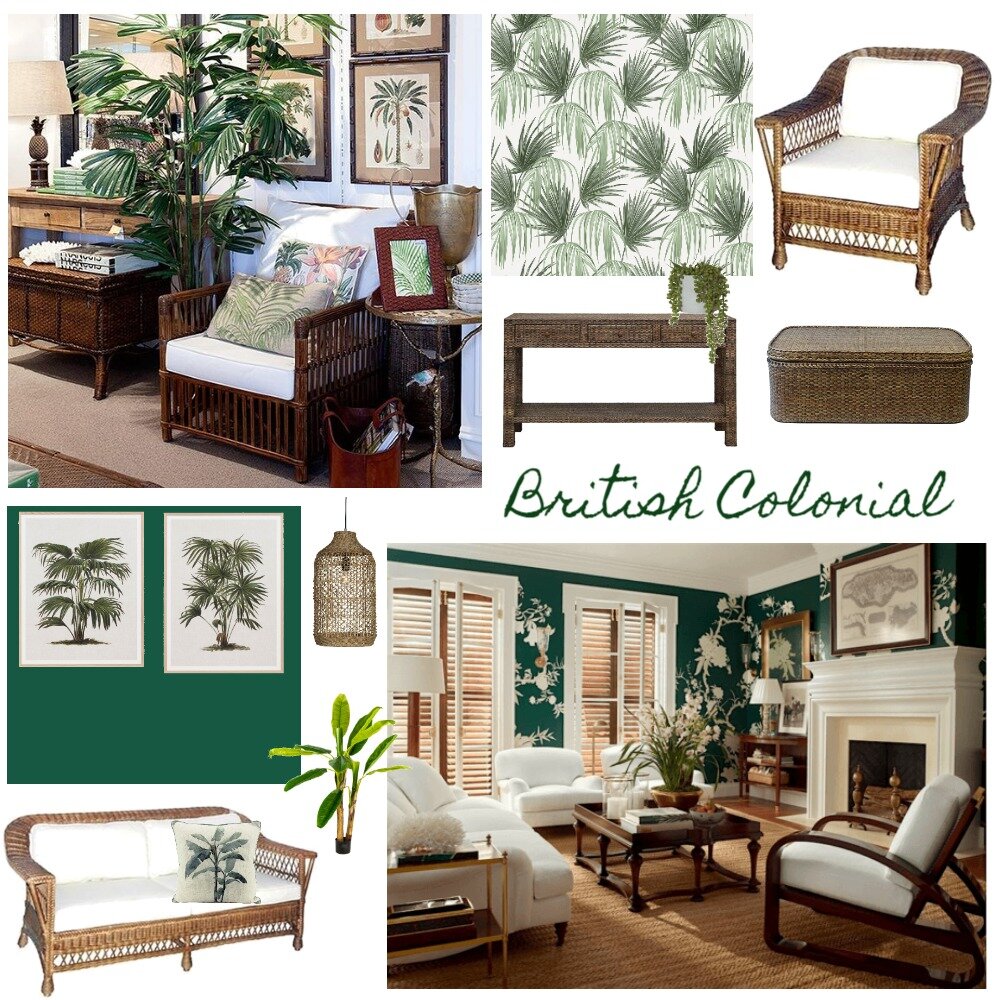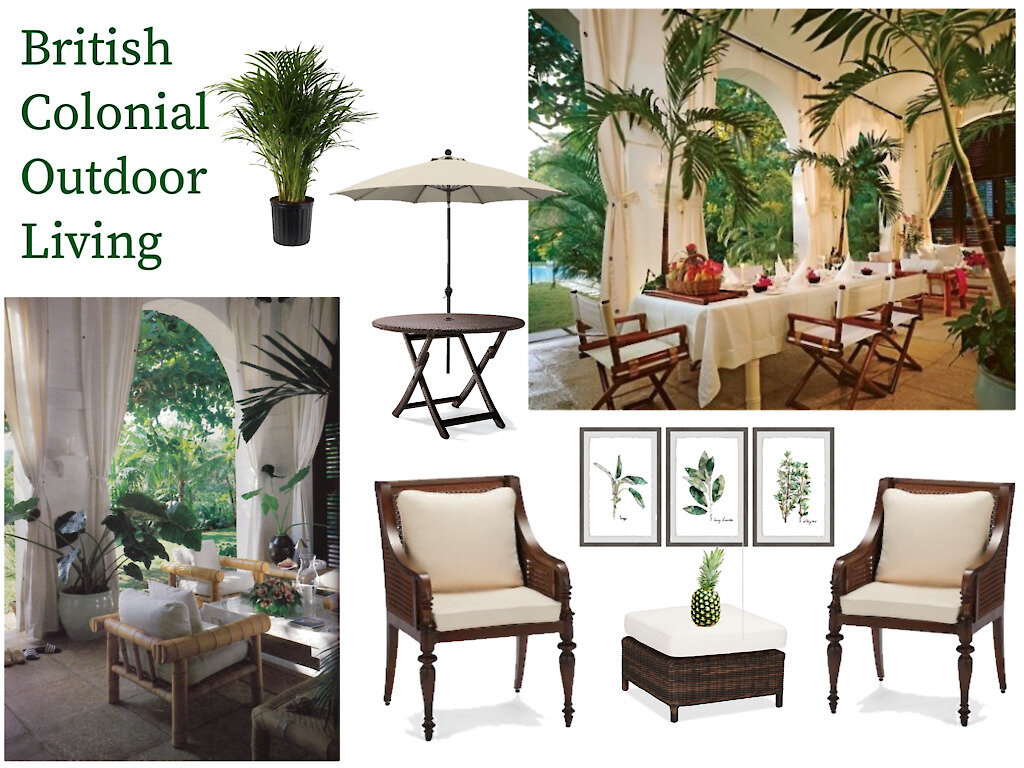Get The Look - British Colonial Style.
Going Troppo for the Tropical Look…
Have you noticed that the recent return of rattan now seems to be morphing into darker and darker hues of rattan? Check out any new season furniture magazine and you will see more and more teak and mahogany coloured rattan items on display. When rattan first reappeared (hello 80s childhood) it was all about tans and whites. Not anymore.
Why is that? And what does it mean?
Well, it means that an old favourite, British Colonial Style (BCS) is back ! If ever there was an example of what is old becoming new again, then this is it.
You might be wondering what British Colonial Style is. Isn’t the British Colonial system long gone?
Well yes it, but that doesn’t mean that the decor style is out of favour.
British Colonial style speaks to a time when the British Empire was still expanding outwards, from the 1600s to 18oos. In fact, I recently read that during this period, the British Empire was 100 times as large as the United Kingdom!
As British colonialists and the military moved to the far outer reaches of the empire, typically warmer, tropical locations, they found that both their furniture and the ways in which they lived their lives were not necessarily well suited to their new environments.
These realisations led to the development of a new style - British Colonial. The British Colonial Style marries then contemporary Victorian decor with influences from the local, surrounding environment and cultures.
In short, British colonial style is characterised by white walls, dark wood floors and furniture, tropical plants and curios that demonstrates the owner’s travels and interest in their new environment (think maps, globes, pictures of tropical plants and birds). The use of shutters and wide fans is also central to the British Colonial Style and was developed in response to climactic realities.
Countries that have inspired BCS
At one time, the British Empire stretched across the known world, from Africa to India, not forgetting parts of Asia and the Caribbean. The merging of these styles produced an eclectic style that celebrated local curios while retaining some elements of European styling. The result is a relaxed and comfortable decor that features accent colours and items against a more achromatic palette.
Key elements
Dark Wood
British colonialists quickly discovered that their Victorian furniture was not built to withstand the temperature and climate of their new tropical homes. As a result, they began looking to local artisans to create Victorian-styled furniture, but made from local woods such as teak and mahogany. All dark woods, this hue is fundamental to what we now know as the British Colonial Style. Like the furniture, floors were also built using these woods and so set a warm and no-fuss base to the new homes.
Whites
Contrasting beautifully with dark floors and furniture, walls were white as were linens and soft furnishings. This helped create a cool and ethereal feeling to rooms - perfect on a hot tropical day.
Rattan
Rattan is a central component of the look, allowing for cool air to circulate through furniture. Often a slightly lighter shade than the flooring, the ideas was for the rattan items to seamlessly blend with the floors and walls of the house.
Flora and fauna
Acknowledging the local flora, the use of plants has been a central feature of the British Colonial Style and helps blur the line between outdoors and indoors.
Whilst plants are important to the look, botanical prints and fabrics can also add texture and a touch of the tropical to the room.
British Colonial Style enthusiasts should also consider investing in animal prints and artwork which work beautifully with the overall aesthetic. Check out the prints below from Olive et Oriel for some modern examples www.oliveetoriel.com
Curios
Central to the emergence of this look was the use of well-used brown and tan leather trunks. Initially used to transport goods and belongings, these items continue to feature in any British Colonial Styled room and serve double purpose as coffee tables and storage.
In keeping with a style borne of travel, it is also common to find all sorts of interesting little curios in a BRC room - for example, globes, writing boxes, maps, candles, telescopes and memorabilia. The mixture of European items with those more commonly found in locations such as Asia, Africa or the Caribbean is a fundamental aspect of the look.
Check out the Globe from www.nationalgeographic,com as well as the blanket box, writing box and trunk, all from www.templeandwebster.com.au
Canopy Bed
Although canopy beds predate the British Colonial Style, this era did radically re-design the canopy bed into a much more tropical style, making use of local wood. The BRC canopy bed adopts a more pared back look, eschewing the heavier European style of the time, and being shrouded in translucent materials that worked to keep out creepy crawleys.
Campaign furniture
A personal favourite, campaign furniture was a key component of the BRC look. So what is it? Campaign furniture is made to collapse into easy to carry pieces. Look out for chairs or desks with criss-cross legs in clean lines and dark woods. Perfect for rooms that serve multiple functions such as a sitting room or guest room that also doubles as a study.
Shutters and fans
White or darker timber shutters are a key design element of British Colonial. Not just beautiful to look at, they also work to protect against the elements, control airflow and filter sunshine.
Coupled with shutters, ceiling fans are an important element of the British Colonial style. Allowing cool air to circulate in a room, they can also be viewed as an accessory, and are typically made in natural materials like timber, rattan and grasses. They contrast beautifully against a high white ceiling or blend comfortably with a thatched roof.
Check out the shutters from www.blindsonline.com.au and the tropical fan from www.templeandwebster.com.au
British Colonial Style in summary.
In summary, if you are interested in replicating this style in your home or next build, here are a few tips.
Darker tones for your woods and natural products such as rattan and bamboos is the way to go.
White walls and lashings of white linen materials provide a beautiful contrast to the darker elements of the room.
Bring the outdoors inside with lots of plants and images of botanical and animal scenes.
Celebrate your travels by featuring those interesting curios you have collected.
Canopy beds are perfect!
Furniture should speak to a time when you might move frequently - check out campaign furniture.
Ceiling fans and shutters not only look great, but are great for moderating the temperature within your house.
















